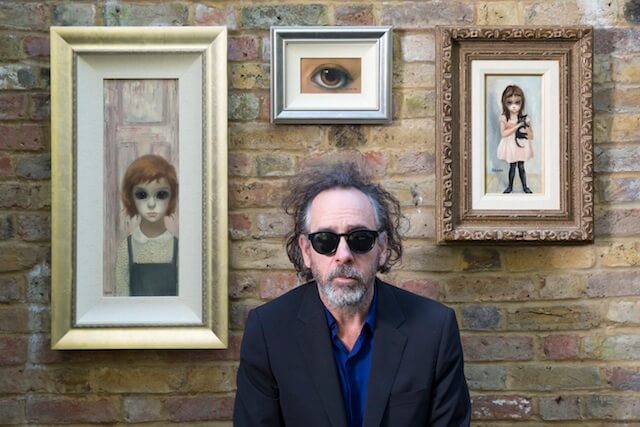Tim Burton hasn’t made a film as small as the comedic docudrama “Big Eyes”… maybe ever? His latest — chronicling the story of Margaret Keane (Amy Adams), a painter whose husband, Walter (Christoph Waltz), look took credit for her immensely popular paintings of sad children with huge eyes — might actually have a smaller budget than “Pee-wee’s Big Adventure” and “Ed Wood,” the latter written, like “Big Eyes,” by Scott Alexander and Larry Karaszewski. It’s a sad story, if one whose Golden Globe nominations (for Adams and Waltz) were classified under Comedy or Musical. Margaret’s paintings were huge. What’s your memory of them from your childhood?
They were all over the place. Prints were in living rooms, restaurants, doctors’ offices, dentists’ offices, supermarkets. When the story broke [that Margaret had painted them], it wasn’t blown out because it wasn’t considered art by critics. If it had been a major artist it would have been embraced by the critical art community. It would have been a front-page story. But this was the third page in the Honolulu News. Did you like her work growing up?
“Liking” is a funny word. I was fascinated by it, because a) it was around and b) I found it disturbing. You’d go to somebody’s house and you’d go, “Why do you have a picture of a crying child on your wall?” They are very strange. Was she at all an inspiration for you?
I guess in a very subconscious way, yes. I’ve drawn characters with big eyes and small pupils. The combination of cute or funny yet disturbing is something I relate to. Her work probably influenced me in terms of that emotional juxtaposition of feelings into one thing. This is the smallest film you’ve made since “Ed Wood,” if not “Pee-wee’s Big Adventure.”
In terms of inflation it could be the smallest*. It just reconnected me to having less people and having to move quicker, move three or four times a day. We had to try and make Vancouver look like San Francisco. It was just about moving quickly — something about the energy of that, which is different than the big budget films. I had to worry about how much everything cost. Big budget films you don’t really do that. Even your biggest films tend to be driven by characters and actors. That can seem odd for someone who came from animation, since you can’t completely control actors.
That’s why I don’t storyboard that much anymore. I learned fairly early on that, obviously, there are things you need to storyboard, but until you get the actors you don’t know what you have. I don’t want to show an actor a storyboard and say, “Do this.” Each one has their own way of working and you try to allow that. You try to gauge each person and let them have their processes. Some of your actors tend to play outsized, but Amy Adams has a very internal quality. A lot of actors I work with I like because they remind me of silent movie actors. But Margaret is such an internal character. I was fascinated by how much she could portray while being so shy and internal. You could easily see that persona as a victim. But she’s not a victim. She went along with it and she was complicit. When she went to court it wasn’t out of vindictiveness. She felt she wanted that weight to come off of her. Even after she wasn’t out there, railing. She’s one of the quietest, under-the-radar feminists I’ve ever met. This is a film set in the 1960s. Did you have any cinematic inspirations from that era?
Strangely it was Mario Bava. I don’t know why. It’s because of the era, but then the paintings suggest a certain lurid bizarreness. They’re so dysfunctional. Talking to Bruno [Delbonnel], the [director of photography], we’d always go back to Bava. There’s a few Bava films where the colors are quite lurid, in a sickly way. They’re bright and colorful and slightly unusual. Even though there wasn’t a direct reference it was something I kept thinking about. It’s slightly weird that the Golden Globes classified this as a comedy. It is funny, but it’s also serious, though one would hesitate to call it a full-on drama.
I don’t know if I could ever make a real drama. [Laughs] I find everything funny. Even horror. I grew up on horror movies. I don’t know if I could make a real one because I always find them quite funny. But I always love a mixture of things. I was surprised at seeing this with an audience, how funny some things come across. Because it’s so absurd. The real life story is so absurd — and it’s tragic. I always felt it was a dark rom-com psychological horror movie comedy. Good luck trying to sell this one! * This is true. “Big Eyes” had a budget of $10 million. “Pee-wee” cost $6 million to make in 1985, which adjusted for inflation, is $13.1 million. “Ed Wood,” incidentally, had a relatively whopping $18 million budget.
Interview: Tim Burton says ‘Big Eyes’ is a ‘dark rom-com psychological horror movie comedy’

The Weinstein Company
Follow Matt Prigge on Twitter @mattprigge

















